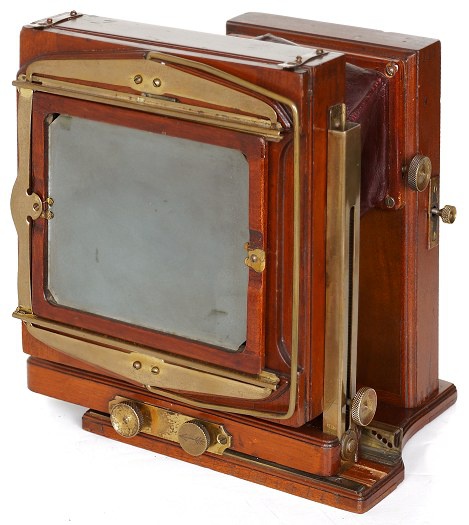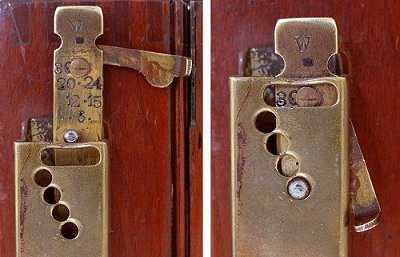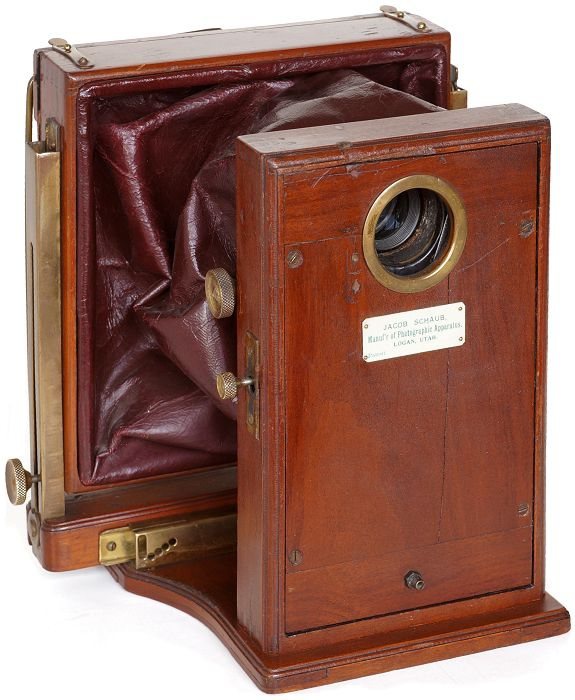|
|





Copyright ©2012 by Rob Niederman - ALL RIGHTS RESERVED
Visit the Schaub Story page
Visit the Schaub Patent Reference page
Return to the View Cameras page
Visit the Schaub Patent Reference page
Return to the View Cameras page
A Novel Approach to Multiplying Camera Design. In
an established market dominated by American Optical,
Anthony, Scovill and Simon Wing, Jacob Schaub tried
to create his own interpretation of a multiplying
camera. It's unclear why he made the effort; maybe
existing designs didn't meet his needs; maybe he
needed something less expensive - we'll never know.
But there you have it, an entrepreneur in Logan, Utah (that's right ... Utah ... almost 2,000 miles from the epicenter of east coast camera makers) going on his own. The result is an intriguingly small single lens, rear shifting design unlike any other.
Three complete cameras are known; two match the 1900 patent making 24 exposures on a 4 x 5 inch plate. The camera presented here is the only example capable of making 30 images on a plate. It also represents an improvement over the other two cameras with the inclusion of a reversing back.
Multiplying Camera Basics There are three basic types of multi-imaging cameras: multi-lens, shifting back and/or front, and apparatus with movng backs and multiple lenses. Multi-lens cameras proved difficult to use because lenses varied no matter how carefully they were made and matched to each other. Additionally, lenses are often the most expensive part of the camera, and costs increase significantly as lenses are added.
In contrast, a shifting rear or front design was less expensive; however, the photographer gave up the ability to make numerous pictures at the same time. Regardless of the design, making numerous 'penny picture' images on a single plate was cost effective and profitable.
And while other designers used pleated bellows and scaled up camera bodies for extreme shifting movements (i.e. very wide backs that were also tall), Schaub used either a rubberized cloth or leather bag bellows. This might be the key reason this camera was made because it creates a smaller overall body pattern. Was this what he had in mind?
But there you have it, an entrepreneur in Logan, Utah (that's right ... Utah ... almost 2,000 miles from the epicenter of east coast camera makers) going on his own. The result is an intriguingly small single lens, rear shifting design unlike any other.
Three complete cameras are known; two match the 1900 patent making 24 exposures on a 4 x 5 inch plate. The camera presented here is the only example capable of making 30 images on a plate. It also represents an improvement over the other two cameras with the inclusion of a reversing back.
Multiplying Camera Basics There are three basic types of multi-imaging cameras: multi-lens, shifting back and/or front, and apparatus with movng backs and multiple lenses. Multi-lens cameras proved difficult to use because lenses varied no matter how carefully they were made and matched to each other. Additionally, lenses are often the most expensive part of the camera, and costs increase significantly as lenses are added.
In contrast, a shifting rear or front design was less expensive; however, the photographer gave up the ability to make numerous pictures at the same time. Regardless of the design, making numerous 'penny picture' images on a single plate was cost effective and profitable.
And while other designers used pleated bellows and scaled up camera bodies for extreme shifting movements (i.e. very wide backs that were also tall), Schaub used either a rubberized cloth or leather bag bellows. This might be the key reason this camera was made because it creates a smaller overall body pattern. Was this what he had in mind?
Multi-Lens Cameras | View Cameras | Self-Casing Cameras | Solid Body Cameras | References & Advertisements
Home | What's New | Show Schedule | Wanted | For Sale | Links | Site Map | Email
Home | What's New | Show Schedule | Wanted | For Sale | Links | Site Map | Email
All of Schaub's multiplying cameras have a tall front panel that is a fixed distance from the rear assembly. A rack and pinion focusing knob moves
a basic tube lens back and forth. The lens is looks like a small 1/9-tube for gem images and probably a petzval formulation for portraits.
Inside the front panel is a simple two-blade scissors style shutter. The second, smaller knurled brass knob on the side of the panel manually opens and closes the shutter for composing and focusing. The small metal nipple at the bottom center of the panel is for a pneumatic bulb and tube to release the shutter.
Inside the front panel is a simple two-blade scissors style shutter. The second, smaller knurled brass knob on the side of the panel manually opens and closes the shutter for composing and focusing. The small metal nipple at the bottom center of the panel is for a pneumatic bulb and tube to release the shutter.
Multiplying Camera, c.1900
Jacob Schaub. Logan, Utah
Jacob Schaub. Logan, Utah
J. Schaub Multiplying Camera
Improved version for 30 exposures on 4 x 5 inch plates
Improved version for 30 exposures on 4 x 5 inch plates
Above Left Aside from the traditional style of reversing ground glass
assembly to change image orientations, the rear standard is a marvel of
engineering for vertical rise-fall and side-to-side shifting of the back. Loading
a plate holder is easily done by pulling on a large 'bale' (the brass rod around
the ground glass) which lifts the ground glass away from the back.
Above Right Making 30 exposures on a 4 x 5 inch plate in a 5 x 6 array requires special registration hardware so that the entire area of the plate can be covered. To demonstrate the extreme movements, the camera is shown with the back adjusted for exposing the lower right portion of the plate.
Below Left and Right The key to making accurate shifting movements that place small images on a plate without overlapping is based on a novel registration system. Registration hardware slides inside a u-shaped brass channel. The number of exposures corresponds to the numbers on the brass slide and a pin registration system. As shown, the camera can be set up to shoot 6, 12, 15, 20, 24, or 30 images.
Above Right Making 30 exposures on a 4 x 5 inch plate in a 5 x 6 array requires special registration hardware so that the entire area of the plate can be covered. To demonstrate the extreme movements, the camera is shown with the back adjusted for exposing the lower right portion of the plate.
Below Left and Right The key to making accurate shifting movements that place small images on a plate without overlapping is based on a novel registration system. Registration hardware slides inside a u-shaped brass channel. The number of exposures corresponds to the numbers on the brass slide and a pin registration system. As shown, the camera can be set up to shoot 6, 12, 15, 20, 24, or 30 images.
As shown in the far right picture, the slide is positioned with '30' showing and a lever is pushed down to secure the setting. This is done for both
the vertical and horizontal movements. Turning a corresponding brass knob shifts the back to lock into one of 5 or 6 positions vertically or
horizontally. It is the photographers responsibility to keep track of where images were exposed on the plate.
For more information about the builder and his camera, Mike Kessler gave me permission to include an excerpt of his excellent 1983 Photographist article entitled; Jacob Schaub: Portrait of an Inventor
For more information about the builder and his camera, Mike Kessler gave me permission to include an excerpt of his excellent 1983 Photographist article entitled; Jacob Schaub: Portrait of an Inventor
